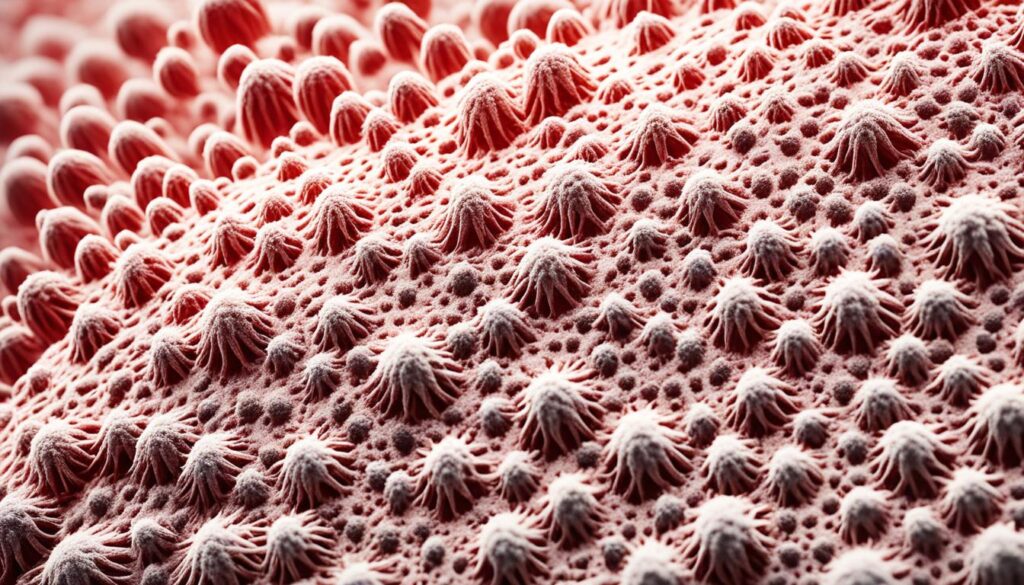Did you know that more than 46 million homes in the U.S. have a cat? Cats are beloved companions, but for those with allergies, owning a cat can be a challenge. However, there is hope for cat lovers who suffer from allergies – hypoallergenic cats. These special breeds of cats produce lower levels of the proteins that trigger allergies, making them a more allergy-friendly option. While there is no completely hypoallergenic cat, certain breeds might be a better fit for allergy sufferers.
Key Takeaways:
- Hypoallergenic cats produce lower levels of allergen-causing proteins.
- Certain cat breeds are known to be more hypoallergenic than others.
- Researching and spending time with a hypoallergenic breed is important before adoption.
- Consulting with an allergy specialist and maintaining a clean home can help minimize allergy symptoms.
- There are no completely hypoallergenic cats, but with proper care, owning a hypoallergenic cat can be a joy.
What Is a Hypoallergenic Cat?
All cats produce allergens, but some breeds produce lower levels of the proteins that cause allergies. These proteins can be found in the cat’s fur, saliva, and urine. Hypoallergenic cats are not completely allergen-free, but they may be a better choice for people who are sensitive to cat allergens.
When it comes to hypoallergenic cat breeds, it’s important to understand the allergy triggers in cats. The proteins that cause allergies are typically found in cat dander, which consists of the dead skin cells that cats shed regularly. Additionally, cats produce allergenic proteins in their saliva and urine, which can also trigger allergies in sensitive individuals.
Despite popular belief, cat hair itself is not an allergen. However, hair can trap and carry the allergenic proteins, which then become airborne and can cause allergic reactions when inhaled or come into contact with the skin.
Hypoallergenic cat breeds are those that produce lower levels of these allergenic proteins, making them potentially more suitable for individuals with allergies. These breeds may cause fewer allergic reactions or milder symptoms in sensitive individuals.
Image:
While no cat is completely hypoallergenic, the reduced allergenic protein levels in certain breeds can make them a better choice for allergy sufferers. It’s important to note that individual reactions to hypoallergenic cats may vary, and it’s recommended to spend time with the specific breed to determine your sensitivity before bringing one home.
11 Cats That Are ‘Hypoallergenic’

When it comes to choosing a cat that is hypoallergenic, there are several breeds that produce fewer allergen-causing proteins. These popular hypoallergenic breeds may be a better fit for individuals with allergies. It’s important to note that each breed has its own grooming needs and temperaments, so spending time with the breed before bringing one home is crucial to see how your allergies react.
Here are 11 hypoallergenic cat breeds:
- Siberian
- Siamese
- Bengal
- Russian Blue
- Sphynx
- Devon Rex
- Cornish Rex
- Javanese
- Balinese
- Oriental Shorthair
- Burmese
These breeds offer a variety of options, each with its own unique characteristics and grooming needs. To ensure you choose the right hypoallergenic cat breed for you, spending time with the breed, consulting with breeders, and understanding their grooming requirements is essential.
Tips for Adopting a Hypoallergenic Cat

When considering adopting a hypoallergenic cat, there are a few important tips to keep in mind. By following these guidelines, you can ensure a smooth transition and a happy, allergy-friendly home.
Do Your Research and Spend Time with the Breed
Before bringing a hypoallergenic cat into your home, it’s crucial to research and learn more about the specific breed you’re interested in. Different hypoallergenic breeds have varying levels of allergen-causing proteins, so spending time with the breed can help you gauge your allergic reactions. Arrange visits with reputable breeders or shelters to interact with the cats and see how your allergies respond.
Consult with an Allergy Specialist
Meeting with an allergy specialist before adopting a hypoallergenic cat is highly recommended. An allergy specialist can assess the severity of your allergies and provide valuable insights and recommendations regarding hypoallergenic breeds. Additionally, they may suggest suitable medication options to help manage your symptoms and improve your quality of life with a cat.
Keep a Clean Home
Maintaining a clean and allergen-free environment is essential when owning a hypoallergenic cat. Regular cleaning can help minimize the presence of allergens in your home. Here are a few cleaning tips to consider:
- Vacuum carpets and upholstery frequently to remove allergens and pet dander.
- Wash bedding and curtains regularly to eliminate allergens that may accumulate on fabric surfaces.
- Invest in a high-quality air purifier to filter out airborne allergens.
- Use hypoallergenic cleaning products that are less likely to trigger allergic reactions.
By implementing these cleaning practices, you can create a more allergy-friendly living space for both you and your hypoallergenic cat.
Consider Hypoallergenic Cat Food and Litter
Choosing hypoallergenic cat food and litter options can further reduce allergens in your home. Look for cat food brands that offer formulas specifically designed to reduce allergen levels. Consulting with your veterinarian can help you select the best hypoallergenic cat food for your furry friend. Similarly, opt for hypoallergenic cat litter to minimize dust and potential allergens.
If you’re unsure about which brand or product to choose, talk to your veterinarian about Purina® Pro Plan® LIVECLEAR. It is a cat food formulated to reduce allergens and is specifically designed for cats with allergies.
Adopting a hypoallergenic cat can be a wonderful experience for both allergy sufferers and feline companions. By conducting thorough research, consulting with professionals, maintaining a clean household, and choosing the right hypoallergenic products, you can create a harmonious and safe environment that allows you to enjoy the company of your furry friend without compromising your well-being.
What Causes People to be Allergic to Cats?

Cat allergies are a common problem for many individuals, and they are primarily caused by certain proteins that cats produce. When cats groom themselves, these proteins are secreted onto their fur and through their saliva, making them pervasive allergens.
The two main proteins that cause allergies in cats are Fel d1 and Fel d4. These proteins can trigger allergic reactions in sensitive individuals when they come into contact with the cat’s hair or dander. It’s important to note that these proteins can be present even in the homes of people who don’t own cats due to their ability to attach to clothing and other surfaces.
Fel d1 Protein
The Fel d1 protein is the most common allergen found in cats. It is primarily produced in the cat’s sebaceous glands, which are located in the skin. When cats groom themselves, Fel d1 spreads throughout their fur, making it easily transferable to humans and causing allergic reactions.
Fel d4 Protein
The Fel d4 protein is another significant allergen found in cats. It is primarily produced in the cat’s salivary and lacrimal glands, which are responsible for saliva and tears. When cats groom themselves, Fel d4 becomes present in their saliva, and it can also be transferred through their tears. This protein can cause allergic reactions when it comes into contact with a person’s skin or mucous membranes.
To help mitigate the impact of these allergenic proteins, regular grooming of cats is essential. Bathing cats can reduce the amount of allergens on their fur, helping to minimize exposure for individuals who are sensitive to cat allergens.
To visually demonstrate the impact of these proteins, here is a table showing the presence of Fel d1 and Fel d4 in different parts of a cat:
| Protein | Location |
|---|---|
| Fel d1 | Sebaceous glands |
| Fel d4 | Salivary and lacrimal glands |
By understanding the proteins that cause allergic reactions in cats, individuals can take appropriate measures to manage their allergies and create a more comfortable living environment.
Are There 100% Hypoallergenic Cats?
All cats secrete allergen-causing proteins, but the levels of secretion can vary between breeds. Hypoallergenic cats are those that produce lower levels of these proteins, making them less likely to cause allergies. However, there are no completely hypoallergenic cats, as all cats produce some level of allergens.
8 Most Hypoallergenic Cats for People with Allergies

If you’re an allergy sufferer but still want to enjoy the company of a feline friend, there are several hypoallergenic cat breeds that may be a good fit for you. These breeds produce fewer allergens and can help reduce the risk of triggering allergic reactions. Let’s explore some of the most hypoallergenic cat breeds:
| Breed | Characteristics | Grooming Needs |
|---|---|---|
| Sphynx | No fur, very affectionate | Regular bathing to remove excess oils |
| Cornish Rex | Curly fur, playful and active | Frequent brushing to prevent matting |
| Devon Rex | Wavy fur, social and mischievous | Regular brushing and nail trimming |
| Oriental | Sleek body, intelligent and vocal | Weekly brushing to remove loose hair |
| Russian Blue | Short, dense fur, calm and gentle | Minimal grooming, occasional brushing |
| Balinese | Long, silky fur, affectionate and playful | Daily brushing to prevent matting |
| Siberian | Thick, water-repellent fur, strong and friendly | Regular brushing to remove loose hair |
| Bengal | Distinctive spotted coat, energetic and adventurous | Regular brushing to maintain coat health |
Each of these breeds have their own unique characteristics and grooming needs. It is important to spend time with the breed to see how your allergies react before making a decision. Additionally, regular grooming and maintaining a clean living environment can further help reduce the risk of allergies.
While these hypoallergenic cat breeds may produce lower levels of allergens, it is important to note that individual sensitivities to cat allergens may still vary. Consult with an allergist or healthcare professional for personalized advice and recommendations.
Remember, finding the right hypoallergenic cat breed can greatly enhance your quality of life, allowing you to enjoy the companionship of a furry friend without the constant discomfort of allergies. Take the time to research and interact with different breeds, and with proper care and consideration, you’ll be well on your way to a harmonious and allergy-friendly pet ownership experience.
Practical Solutions for Common Litter Box Issues
When it comes to cat ownership, one of the key responsibilities is ensuring that your furry friend has a clean and comfortable litter box. However, issues can arise that may affect your cat’s litter box habits and overall hygiene. To address these common litter box issues, I have outlined some practical solutions below:
Maintaining Litter Box Hygiene
Regular cleaning and maintenance of the litter box are essential to promote good litter box hygiene. Cats are naturally clean animals, and they prefer a clean and odor-free environment for their bathroom needs. To avoid any litter box issues, make sure to:
- Scoop the litter box daily: Removing waste promptly will keep the litter box clean and prevent odor buildup.
- Replace litter regularly: Depending on the type of litter, it’s essential to replace it every one to two weeks to ensure cleanliness and freshness.
- Wash the litter box: Every few months, thoroughly clean the litter box with mild soap and water to remove any lingering odors and bacteria.
Choosing the Right Litter Box and Litter
The type of litter box and litter you choose can significantly impact your cat’s litter box experience. Consider the following factors when selecting the right litter box and litter:
- Litter box size: Choose a litter box that allows your cat to move comfortably and provides enough space for digging and covering waste.
- Litter box design: Some cats prefer open litter boxes, while others may prefer the privacy of a covered litter box. Observe your cat’s preferences and choose accordingly.
- Litter type: There are various types of litter available, including clumping, non-clumping, scented, and unscented. Experiment with different types to find the one that suits your cat’s preferences.
Strategic Placement of the Litter Box
The location of the litter box plays a crucial role in your cat’s comfort and accessibility. Consider the following tips for strategic placement:
- Quiet and secluded: Place the litter box in a quiet area away from high-traffic zones in your home to provide your cat with a sense of privacy.
- Accessible location: Ensure that the litter box is easily accessible for your cat, especially if they have mobility issues or are elderly.
- Avoid obstructions: Keep the litter box away from obstructions or obstacles that may hinder your cat’s entry or exit.
By strategically placing the litter box, you can minimize stress and increase your cat’s comfort while using it.
Reducing Stress
Cats are sensitive creatures, and stress can significantly impact their litter box habits. To reduce stress and prevent litter box issues, consider the following:
- Create a calm environment: Provide a peaceful and stress-free environment for your cat by minimizing noise, introducing vertical spaces, and offering hiding spots.
- Address behavioral issues: If your cat is exhibiting abnormal litter box behavior, consult with a veterinarian or a cat behaviorist to identify and address any underlying behavioral issues.
- Use positive reinforcement: Reward your cat with treats, praise, or playtime when they use the litter box correctly to reinforce positive litter box habits.
Reducing stress in your cat’s environment can go a long way in preventing litter box issues and promoting their overall well-being.
By implementing these practical solutions, you can effectively address common litter box issues and ensure that your cat has a clean and comfortable bathroom experience.
In the next section, we will explore how to create a cat-friendly home, providing a comfortable environment for your feline companion.
Creating a Cat-Friendly Home
When it comes to ensuring the well-being of our feline friends, creating a cat-friendly home is crucial. A cat-friendly environment provides comfort, security, and stimulation for your beloved pet. Here are some essential elements to consider:
Comfortable Resting Places
A cat-friendly home should have cozy resting places where your cat can take leisurely naps. Provide them with soft beds, blankets, or even dedicated cat hammocks. These comfortable spots will ensure that your cat feels safe and relaxed.
Interactive Toys
Keep your cat entertained with a variety of interactive toys. Toys that mimic prey, such as feather wands or treat-dispensing puzzles, are excellent choices. Interactive playtime not only stimulates your cat’s hunting instincts but also helps prevent boredom and behavior problems.
Scratching Posts
Scratching is a natural behavior for cats and helps them maintain healthy claws. To protect your furniture, provide multiple scratching posts throughout your home. Choose sturdy posts covered in sisal rope or carpet to entice your cat to scratch them instead of your couch.
Cat Furniture and Hiding Spots
Cat furniture, such as scratching trees, cat towers, or shelves, can provide vertical spaces for your cat to explore and feel secure. These pieces also create opportunities for climbing, perching, and observing their surroundings. Additionally, cats enjoy cozy hiding spots, such as enclosed beds or cubbies, where they can retreat when they need some quiet time.
A cat-friendly home is a haven for our feline companions. By providing a comfortable environment, offering interactive toys, and incorporating cat furniture and hiding spots, you can create a sanctuary where your cat can thrive and be truly content.
| Benefits of a Cat-Friendly Home | Examples |
|---|---|
| Increases the overall well-being of your cat | Soft beds, scratching posts, interactive toys |
| Reduces stress and anxiety | Hiding spots, vertical spaces |
| Prevents destructive behavior | Scratching posts, interactive toys |
| Promotes physical exercise | Cat towers, shelves for climbing |
Conclusion
In conclusion, hypoallergenic cats can be a great choice for people with allergies. While no cat is completely hypoallergenic, certain breeds produce fewer allergens and may be a better fit for allergy sufferers. These breeds, such as the Siberian, Siamese, and Russian Blue, have lower levels of the proteins that trigger allergies, making them more tolerable for those with sensitivities.
Taking care of a hypoallergenic cat involves regular grooming to minimize the spread of allergens, such as brushing their fur and bathing them if needed. Additionally, choosing the right cat food and litter can help reduce potential allergens in your home. Consider using hypoallergenic cat food and litter that are specifically formulated to minimize allergens and promote a healthier environment for both you and your feline companion.
Addressing litter box issues is also important when caring for a hypoallergenic cat. Pay attention to the cleanliness of the litter box, as this can impact both your cat’s comfort and the overall air quality in your home. Providing a quiet and accessible location for the litter box can also help encourage proper usage. If any issues arise, addressing them promptly can help maintain a pleasant living environment for everyone.
With the right care and consideration, owning a hypoallergenic cat can lead to a sniffle-free and happy life together. Remember to consult with a veterinarian for specific guidance on grooming, nutrition, and any other allergy-related concerns. By making informed choices and creating a cat-friendly environment, you can enjoy the companionship of a hypoallergenic cat without compromising your well-being.
FAQ
What is a hypoallergenic cat?
Which cat breeds are considered hypoallergenic?
What should I consider before adopting a hypoallergenic cat?
What causes people to be allergic to cats?
Are there 100% hypoallergenic cats?
What are the most hypoallergenic cats for people with allergies?
How can I address common litter box issues?
How can I create a cat-friendly home?
Are there specific cat foods and litters that are hypoallergenic?
References
| International Cat Association (TICA) | https://www.tica.org/ |
| The Cat Fanciers’ Association (CFA) | https://cfa.org/ |
| World Cat Federation (WCF) | https://www.wcf-online.de/ |
| Fédération Internationale Féline (FIFe) | https://www.fifeweb.org/ |








[…] the breed standard and providing proper care are essential for maintaining a Rottweiler’s health and […]
[…] Cats are one of the most popular cat breeds in the […]
[…] you may encounter. Remember, your veterinarian is your best resource for information and advice on cat care, including the administration of liquid medications. By following their recommendations, you can […]
[…] to another, and individual factors can influence the pace of adaptation. Patience and consistent care are key in supporting cats during this transition […]